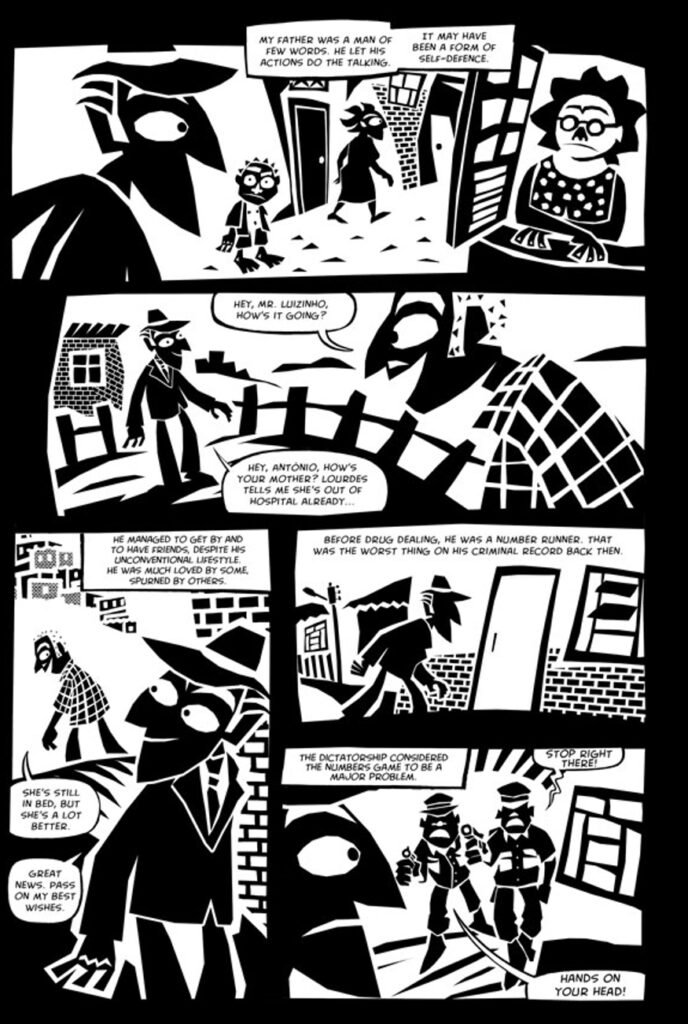Creators : André Diniz & Maurício Hora
Publisher (English edition) : SelfMadeHero
Year : 2011 (original Portuguese) – 2012 (English edition)
What a favela is does not take long to answer: a place where people with next to no money live. Poverty abounds, then, and where poverty rules, so rule criminality, ignorance, brutality and ugliness; here is how it seems the story goes, thus enabling our points of view to be built upon a dichotomy that puts slums into the category of “no-go-zone” for lovers of order and beauty, and the pristine neighbourhoods we see in many a picture of the – not just American – suburbs that are home to cleanliness and tranquility.
Yet, the eye of the anthropologist, just as much as that of the artist (be they writers, poets, painters), knows that even in those places where no beauty appears to dwell there actually is the chance that in all that external chaos the ravishing secular miracle of an extraordinary life might lie; a slum, in other words, has not the same meaning for a visitor as it has for a dweller, meaning that things are not always as clear-cut as they might at first seem to be.

We need to train the eye, then, if we want to discern the silent explosion of inner beauty that images of common lives treasure inside them.
Basing its plot on creator Mauricio Hora’s life, what artist André Diniz does here is not simply a matter of giving us readers a glimpse into of how a small child manages to escape from a future that is doomed to be either that of a gangster or that of a drug-addict. The main character, a young Maurício, does not go from rags to riches, neither does he believe that the only way to manage to have a normal life is that of leaving his favela behind.
If there is a structure at work, here, is not simply that of showing us how a boy finds his vocation in life, that of a photographer, rather how even the most terrible situations can hide a plethora of fragments which, taken one by one, build up a series of interconnected events.
By showing us the figure of Maurício’s father, for instance, we are made privy to a point of view which is, by itself, the mirror of another mirror, as the drawings are the interpretation of Hora’s memories by Diniz, and yet, at the same time, such memories are filtered through imagination, as some of the events we read about actually do cross the limits of personal experience.

The is little social commentary per se, here, as in the idea of trying to explain why things are the way they are. The manner Messrs Hora and Diniz have structured the novel, in fact, is such that it is left to us to make sense of what the deeper meaning of the situations and their accompanying – and masterfully rendered – drawings is; Maurício is simply telling a story that tries to explain why he feels so enamoured with the kind of chaotic world he lives in, where the stability of what we call “a normal life” is not an option.
The act of finding beauty where beauty does not seem to be is therefore not an act of rebellion against the world he lives in, rather that of showing the external world (our world?) that dignity is not a characteristic which has been barred from entering the favela.
By using a camera to record the aesthetic presence of humanity in a place that seems to have been abandoned by all human beings, the inhabitants of such place are given a new life which had been hiding under the strata of poverty and the dissolution of the self (the inhabitant of a favela is a non-persona, an element that needs to be got rid of in the structure of civilization and modernity, an odd byproduct of progress).
As the story plays with only a duality of colours, black and white, the result of such choice is that we feel perhaps more strongly immersed in the pages. There is little denying that the style Mr Diniz makes use of finds itself between chaos and order, a perfect example of the artist’s ability to balance the pages and so spring the reader the eerie feeling that only reality looked through the eyes of a distorting mirror can provide. It is, in fact, a masterful pencil the one that traces the black spaces filling the white voids that combine to present a clear picture of what the beauty of this particular favela is capable of.
It’s the intrusion into a man’s life, then, what this novel is, but it’s also a reflection on the meaning of finding an artistic shape when focusing our eyes on what is usually seen as despicable. It is going to be difficult to look at Brazil’s most famous urban landscape after reading this novel without thinking of the meaning of dignity (of the place, of the inhabitants), and this is a testament to Mr Diniz’ mastery of the medium.

